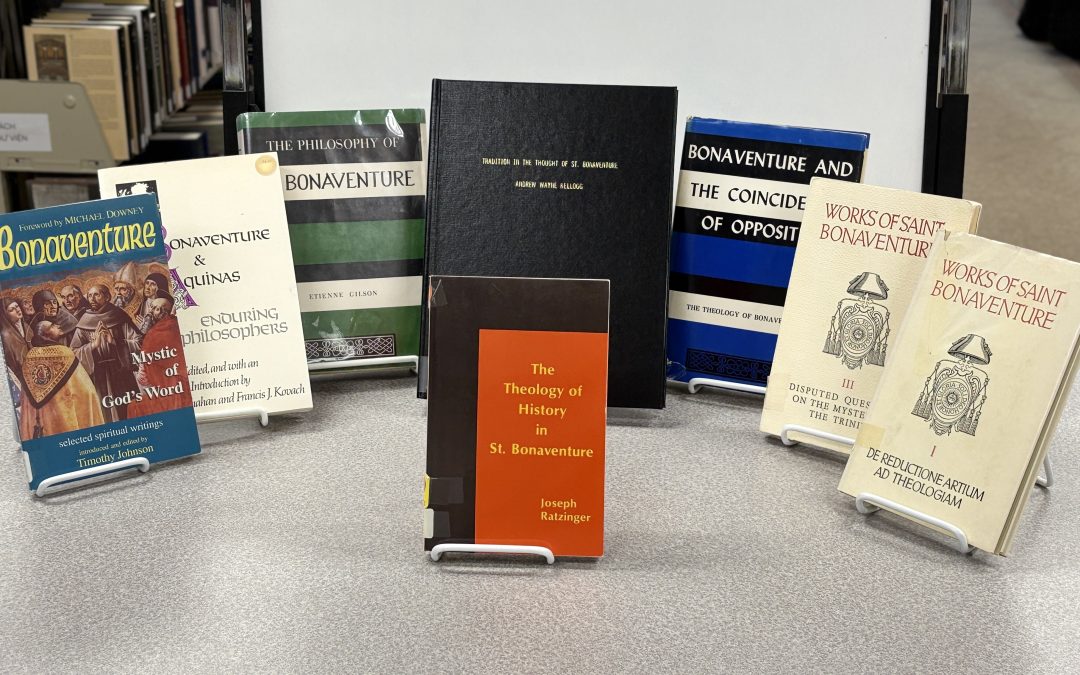
Nov 12, 2025 | Library
Saint Bonaventure
St. Bonaventure (c. 1217–1274) was an Italian medieval Franciscan friar, cardinal, theologian, and philosopher, known as the “Seraphic Doctor” for his piety and theological writings. He served as the Minister General of the Franciscan Order and helped to mediate internal disputes within the order. His influential works include The Mind’s Road to God and the Life of St. Francis.
Born Giovanni di Fidanza, he was healed from a serious childhood illness through the prayers of St. Francis of Assisi, who foretold his future greatness. He later entered the Franciscan Order and studied in Paris, where he became a close friend of St. Thomas Aquinas. He was appointed as the Cardinal-Bishop of Albano in 1273. He died in 1274 while attending the Second Council of Lyon.
St. Bonaventure was canonized in 1482 and declared a Doctor of the Church in 1557 for his significant contributions to Catholic theology through his writings and study. His works are noted for their mystical and contemplative approach to spirituality and theology.
He is honored for his role in guiding the Franciscan Order and for his intellectual and spiritual contributions to the church.
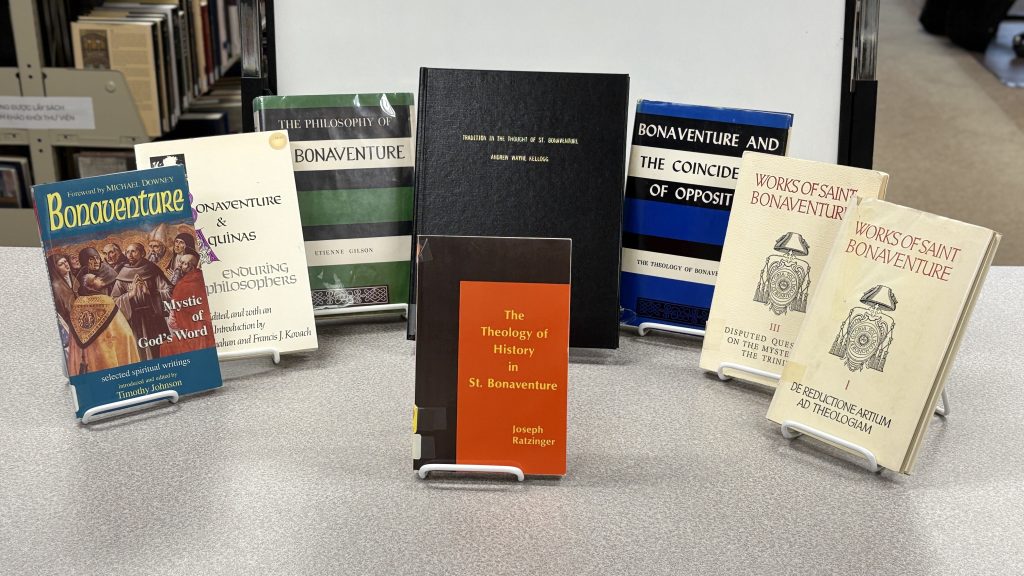
BIBLIOGRAPHY
Cousins, Ewert. Bonaventure and the Coincidence of Opposites. Chicago, IL: Franciscan Herald Press. 1978.
Gilson. Etienne. The Philosophy of St. Bonaventure. Paterson, NJ: St. Anthony Guild Press. 1965.
Hayes, Zachary. Works of Saint Bonaventure: Disputed Questions of the Mystery of the Trinity. Saint Bonaventure, NY: The Franciscan Institute. 1979.
Healy, Sr. Emma Therese. Works of Saint Bonaventure: Volume I. Saint Bonaventure, NY: The Franciscan Institute. 1955.
Johnson, Timothy. Bonaventure: Mystic of God’s Words. Hyde Park, NY: New City Press.1999.
Ratzinger, Joseph. The Theology of History in St. Bonaventure. Chicago, IL: Franciscan Herald Press. 1989.
Shahan, Robert W. and Kovach, Francis J. Editors. Bonaventure & Aquinas: Enduring Philosophies. Norman, OK: University of Oklahoma Press. 1976.

Oct 13, 2025 | Library
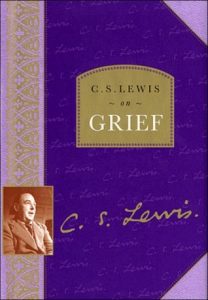 C.S. Lewis on Grief invites readers into the unguarded, luminous honesty of a mind and heart walking through loss. Drawing deeply from A Grief Observed and related writings, this collection showcases Lewis at his most personal: wrestling with God, naming sorrow without varnish, and tracing the bewildering currents of anger, fear, numbness, and aching love that bereavement brings. Here is not a clinician’s distance but a companion’s nearness—an eloquent witness who refuses easy answers and instead offers language for what so often feels unspeakable.
C.S. Lewis on Grief invites readers into the unguarded, luminous honesty of a mind and heart walking through loss. Drawing deeply from A Grief Observed and related writings, this collection showcases Lewis at his most personal: wrestling with God, naming sorrow without varnish, and tracing the bewildering currents of anger, fear, numbness, and aching love that bereavement brings. Here is not a clinician’s distance but a companion’s nearness—an eloquent witness who refuses easy answers and instead offers language for what so often feels unspeakable.
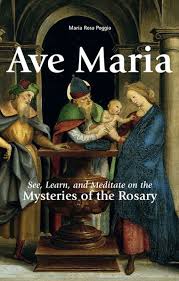 Ave Maria: See Learn and Meditate on the Mysteries of the Rosary is a beautiful companion for anyone seeking to enter more deeply into this timeless prayer. With a gentle, accessible approach, it reveals the Rosary as a path of love through the life of Christ and Our Lady—seen, learned, and lived in the heart.
Ave Maria: See Learn and Meditate on the Mysteries of the Rosary is a beautiful companion for anyone seeking to enter more deeply into this timeless prayer. With a gentle, accessible approach, it reveals the Rosary as a path of love through the life of Christ and Our Lady—seen, learned, and lived in the heart.
A guide to praying the rosary that lends itself to personal prayer and meditation as well as in communal prayer. Embellished with beautiful, full-color art.
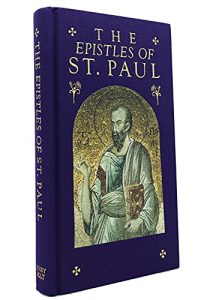 This edition of the 14 epistles of St. Paul presents the complete text from the King James Version of the Bible and illustrates it with a rich variety of illuminated manuscripts and other paintings. 200 full-color illustrations.
This edition of the 14 epistles of St. Paul presents the complete text from the King James Version of the Bible and illustrates it with a rich variety of illuminated manuscripts and other paintings. 200 full-color illustrations.
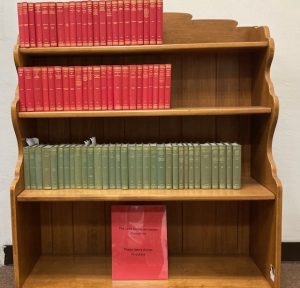 The Loeb Classical Library is a long-running series of books that presents the texts of ancient Greek and Latin authors with authoritative English translations on facing pages. Founded by James Loeb in 1911 and published by Harvard University Press, the series aims to make classical literature accessible to both scholars and general readers.
The Loeb Classical Library is a long-running series of books that presents the texts of ancient Greek and Latin authors with authoritative English translations on facing pages. Founded by James Loeb in 1911 and published by Harvard University Press, the series aims to make classical literature accessible to both scholars and general readers.
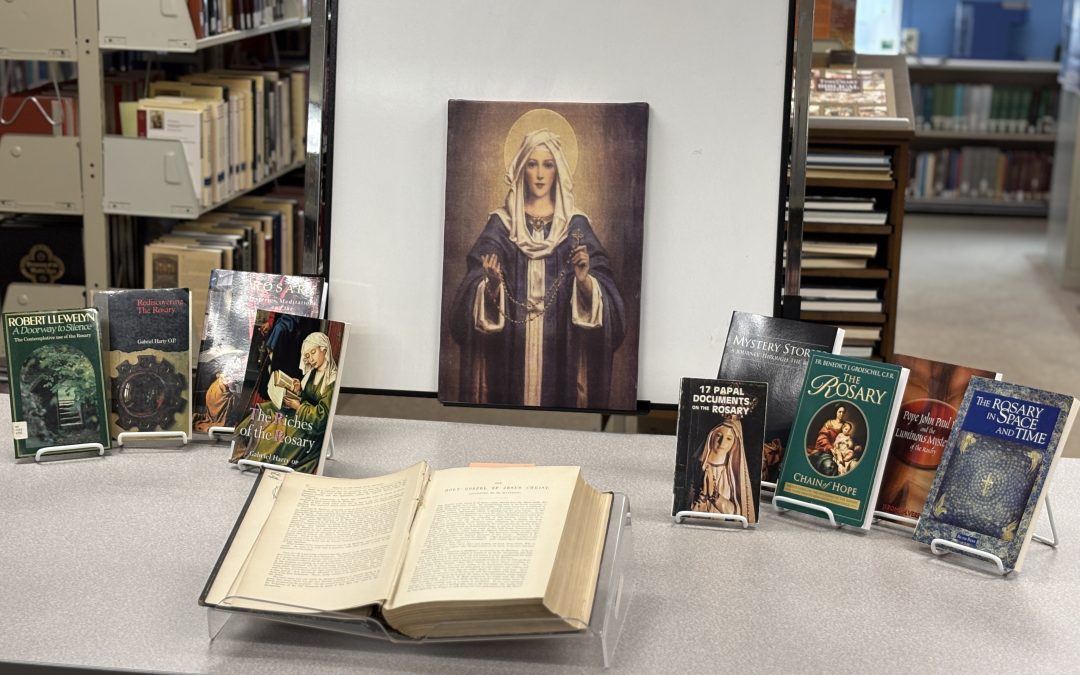
Oct 13, 2025 | Library
The Virgin Mary and The Rosary
In 1569, the papal bull Consueverunt Romani Pontifices established the devotion to the rosary in the Catholic Church. The Christian victory at the Battle of Lepanto in 1571 was attributed to the praying of the rosary by masses of Europeans based on the request of Pope Pius V and eventually resulted in a feast day for Our Lady of the Rosary (originally Our Lady of Victory). In 2002, Pope John Paul II introduced the Luminous Mysteries – based on a compilation by George Preca, the first Maltese saint – as an option in an apostolic letter on the rosary, Rosarium Virginis Mariae.
The Rosary of the Virgin Mary, which gradually took form in the second millennium under the guidance of the Spirit of God, is a prayer loved by countless Saints and encouraged by the Magisterium. Simple yet profound, it still remains, at the dawn of this third millennium, a prayer of great significance, destined to bring forth a harvest of holiness. It blends easily into the spiritual journey of the Christian life, which, after two thousand years, has lost none of the freshness of its beginnings and feels drawn by the Spirit of God to “set out into the deep” (duc in altum!) in order once more to proclaim, and even cry out, before the world that Jesus Christ is Lord and Saviour, “the way, and the truth and the life” (Jn 14:6), “the goal of human history and the point on which the desires of history and civilization turn”.
The Rosary, though clearly Marian in character, is at heart a Christocentric prayer. In the sobriety of its elements, it has all the depth of the Gospel message in its entirety, of which it can be said to be a compendium It is an echo of the prayer of Mary, her perennial Magnificat for the work of the redemptive Incarnation which began in her virginal womb. With the Rosary, the Christian people sit at the school of Mary and are led to contemplate the beauty of the face of Christ and to experience the depths of his love. Through the Rosary, the faithful receive abundant grace, as though from the very hands of the Mother of the Redeemer.
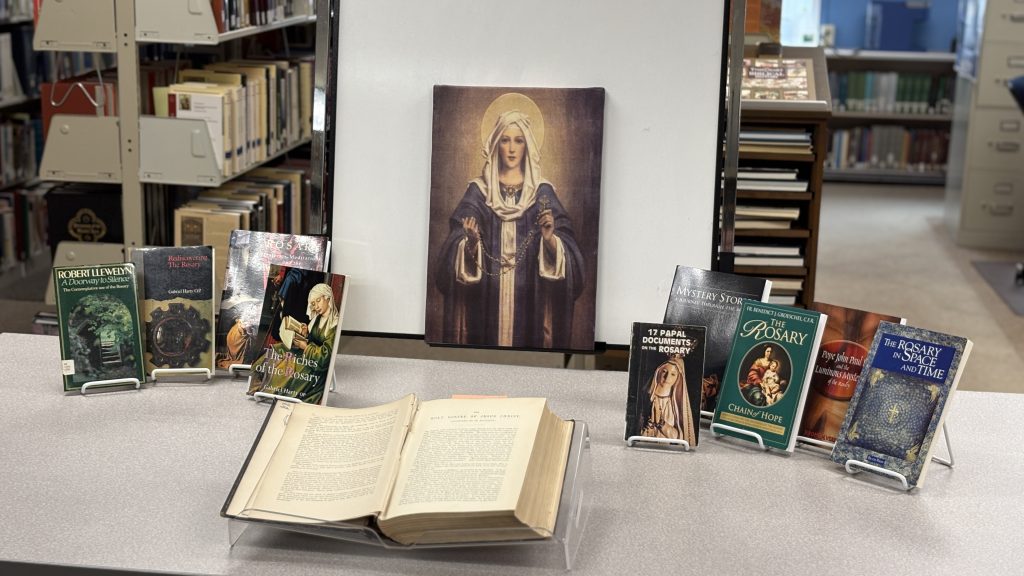
BIBLIOGRAPHY
Carney, James L. Mystery Stories: A Journey Through the Rosary. Madison, WI: Crown of Mary Publishing 2000.
Groeschel, Fr. Benedict. The Rosary: Chain of Hope. San Francisco: CA Ignatius Press 2003.
Harty, Gabriel. The Riches of the Rosary. Dublin, Ireland: Veritas Publications 1997.
Harty, Gabriel. Rediscovering the Rosay. Dublin, Ireland: Veritas Publications 1983.
Johnson, Kevin Orland. Rosary Mysteries, Meditations, and the Telling of the Bead. Dallas, TX: Pangaevs Press 2007.
Llewelyn, Robert. The Doorway to Silence: The Contemplative use of the Rosary. Mahwah, NJ: Paulist Press 1986.
Pope Paul VI, Pope John XXIII, Pope Leo XIII. 17 Papal Documents on the Rosary. Boston, MA: Daughters of St. Paul 1980.
Rees, Ruth. Rosary in Space and Time. Chicago, IL: Liturgy Training Publications 2004.
Vereb, Jerome M. Pope John Paul II and the Luminous Mysteries of the Rosary. Totowa, NJ: Catholic Book Publishing Co. 2003.
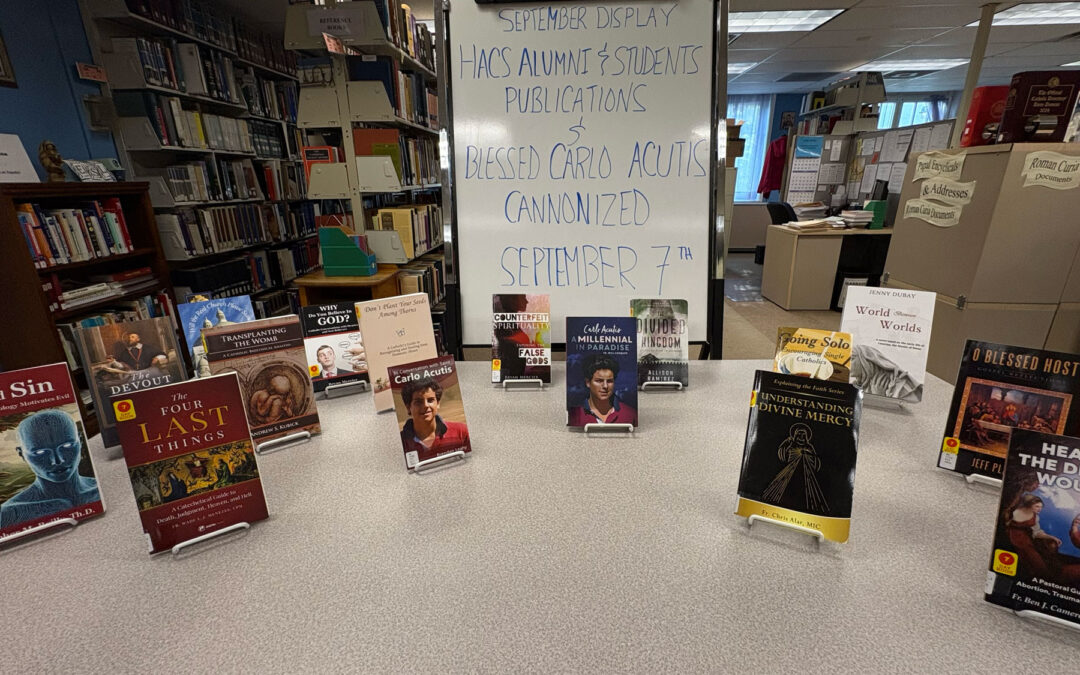
Sep 16, 2025 | Library
SAINT CARLO ACUTIS BACKGROUND
Carlo Acutis was born on May 3, 1991, in London, England, and died on October 12, 2006, in Monza, Italy, succumbing to leukemia at the age of 15.
On September 7, 2025, Pope Leo XIV canonized Saint Carlo Acutis in St. Peter’s Square with an estimated 80,000 pilgrims present, including his parents and twin siblings who were born after he died.
Carlo Acutis built multilingual websites to spread Catholic teaching, later earning him the nickname “God’s influencer”.
An hour before the mass, St Peter’s Square had filled with tens of thousands of pilgrims from around the world, many of them millennial Italians and Americans, as Acutis’s family looked on. The witnesses described the atmosphere as joyous and party-like.
Pope Francis beatified Carlo Acutis after two miracles: Carlo healed a 3-year-old boy in Brazil in 2013 who had been diagnosed with a malformation of his pancreas since birth and Carlo’s intercession involving a 21-year old girl from Costa Rica named Valeria Valverde, who was near death after seriously injuring her head in a bicycle accident while studying in Florence in 2022.

BIBLIOGRAPHY – HOLY APOSTLES STUDENTS & ALUMNI PUBLICATIONS AND ST. CARLO ACUTIS
Cameron, Fr. Ben J. Healing the Deepest Wounds. St. Louis, MO: Mater Media 2024.
DuBay, Jenny. Don’t Plant Your Seeds Among Thorns: A Catholic’s Guide to Reorganizing and Healing from Domestic Abuse. St Louis, MO: En Route Books & Media 2024.
DuBay, Jenny. World Between Worlds. St. Louis, MO: En Route Books & Media 2025.
Kubick, Andrew S. Transplanting the Womb: A Catholic Bioethical Analysis. Boomall, PA: National Catholic Bioethics Center 2025.
Menzes, Fr. Wade L.J. The Four Last Things: A Catechetical Guide to Death, Judgement, Heaven, and Hell. Irondale, AL: EWTN Publishing 2017.
Mercier, Bryan. Counterfeit Spirituality: Exposing False Gods. Huntington, IN: Our Sunday Visitor Publishing 2020.
Mercier, Bryan. Why Do You Believe in God? Milford, CT: Bryan Mercier self-published 2016.
Newsome, Deacon Matthew. The Devout Life: A Modern Guide to Practical Holiness with St. Francis de Sales. Manchester, NH: Sophia Institute Press 2023.
Plante, Jeff. O Blessed Host: Gospel Reflections. Bloomington, IN: West Bow Press 2024.
Ramirez, Allison. The Divided Kingdom. Seattle, WA: Trinity Tree Publishing 2023
Reilly, Christopher M. AI and Sin: How Today’s Technology Motivates Evil. St. Louis, MO: En Route Books & Media 2025.
Stokes, Ann. Going Solo: Encouraging Single Catholics. St. Louis, MO: Enroute Books & Media 2025.
Stokes, Ann. Will the Real Church Please Stand! A Conversion Journey from Fundamental Baptist to Roman Catholic. St Louis, MO: En Route Books & Media 2023.
BIBLIOGRAPHY – ST. CARLO ACUTIS
Conquer, Fr. Will. Carlo Acutis: A Millennial Saint. Manchester, NH: Sophia Institute Press 2021
Gori, Nicola. Carlo Acutis: The First Millennial Saint. Huntington, IN: Our Sunday Visitor Publishing 2021.
Leahy, Brendan. In Conversation with Carlo Acutis. New York City, NY: New City Press 2025.
ARCHIVAL BOOK SELECTED
Title: The Life of our Most Holy Father St. Benedict Being the Second Book of the Dialogues of St. Gregory the Great with the Rule of the Sem Holy Patriarch
Language: English
Publisher: “One of the Benedictine Fathers of St. Michael near Hereford
Date/Place Published: Rome 1895
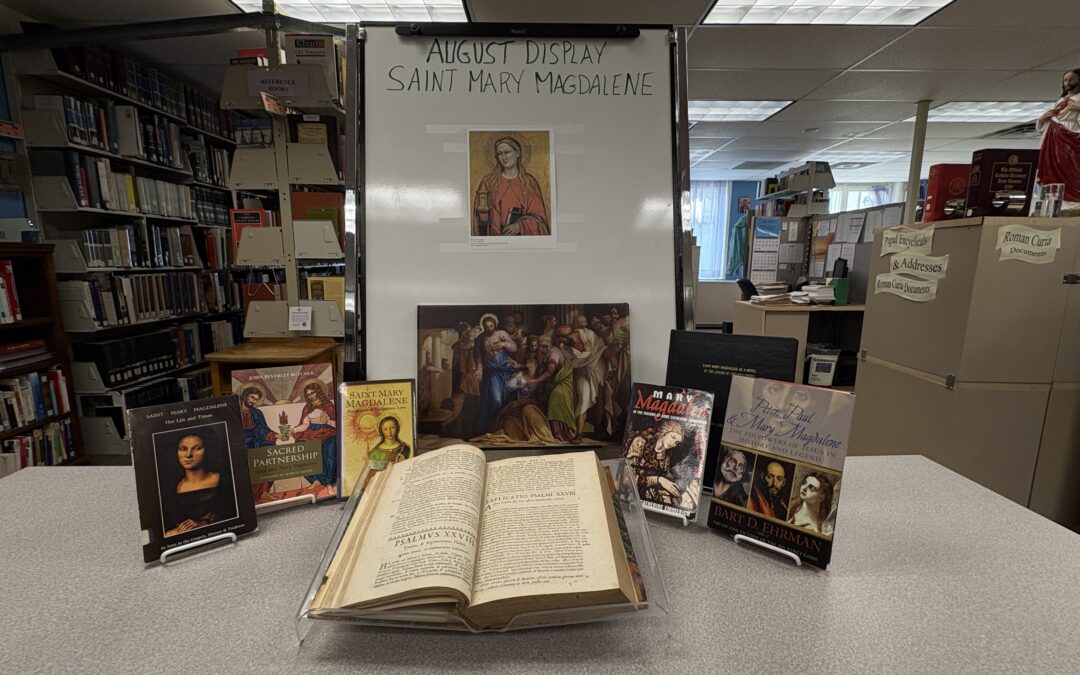
Aug 8, 2025 | Library
SAINT MARY MAGDALENE BACKGROUND
Mary Magdalene was a historical figure; she was born circa AD 8, possibly in Magdala, Roman Judea. She was a prominent follower of Jesus who was believed to have been healed by him, supported his ministry financially, and was present at his crucifixion and burial. She played a key role among his female disciples. Overall, there is limited information about her life.
Apocryphal early Christian writings often portray Mary Magdalene as a prominent, spiritually insightful figure favored by Jesus, challenging traditional patriarchal norms. These texts have inspired modern reinterpretations of her role. During the Patristic era, Mary Magdalene was mentioned only briefly by early Church Fathers, with her image evolving from a minor gospel figure to being conflated with other women in the Bible. Eventually, she became viewed in Western Christianity, largely due to Pope Gregory I’s influential 591 sermon, as a repentant prostitute, despite there being no biblical basis for this portrayal.
The Eastern Orthodox Church has always viewed Mary Magdalene as a virtuous Myrrhbearer and “Equal to the Apostles”, distinct from other biblical women. The Roman Catholic Church historically conflated her with the repentant sinner in Luke 7 but later emphasized her role as the first witness to the resurrection and honored her as the “Apostle to the Apostles”. Many alleged relics of Mary Magdalene, including her skull, a piece of forehead flesh, a tibia, and her left hand, are preserved in Catholic sites in France and Mount Athos, with notable displays and annual processions honoring them. Her feast day is July 22nd.
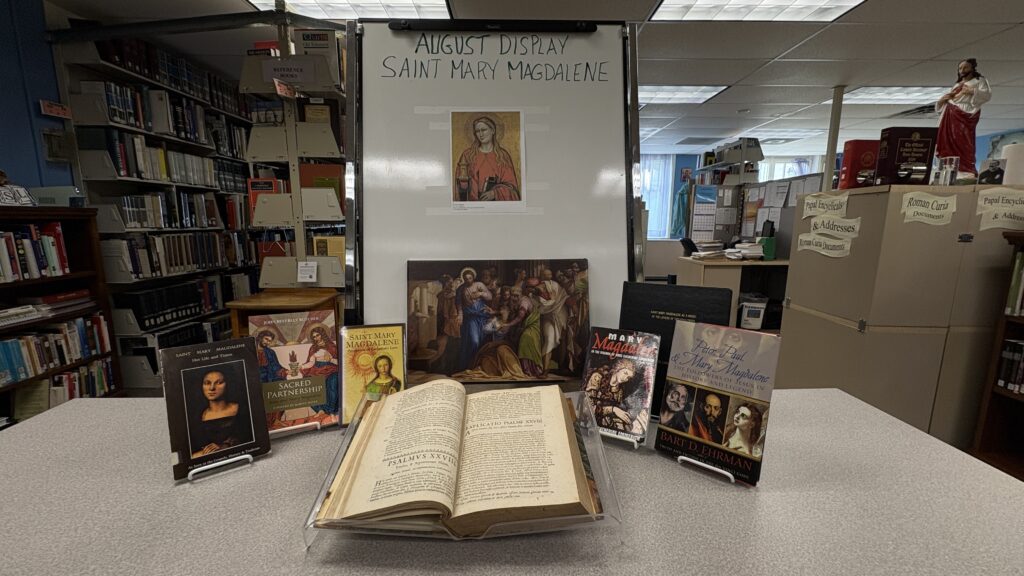
SAINT MARY MAGDALENE – BIBLIOGRAPHY
Butcher, John Beverley. Sacred Partnership: Jesus and Mary Magdalene. Hannacroix, NY: Apocryphile Press. 2011
Davidson, Fr. Sean. Saint Mary Magdalene Prophetess of Eucharistic Love. San Francisco, CA: 2017.
Ehrman, Bart D. Peter, Paul, & Mary Magdalene: The Followers of Jesus in History and Legend. New York, NY: Oxford University Press. 2006.
Emmerich, Anne Catherine. Mary Magdalene: In the Visions of Anne Catherine Emmerich. Rockford, IL: Tan Books 2005
Filliette, Edith. Saint Mary Magdalene: Her Life and Times. Newton Lower Fall, MA: Society. 1983. of Mary Magdalene
Ho, Sr. Loan Hong. Mary Magdalene as a Model of the Lovers of the Holy Cross. Cromwell, CT: Holy Apostles College & Seminary. Master’s Thesis 2016.
COPY OF PAINTING DISPLAYED: The Conversion of Mary Magdalene, painted by Paolo Veronese, 1548.
COPY OF PICTURE DISPLAYED: Saint Mary Magdalene, painted by Antonio Veneziano circa 1369-1419
ARCHIVAL BOOK SELECTED
Author: Bellarmino, Saint Roberto Francesco Romolo (1542-1621)
Title: Explanatio in Psalmos
Language: Latin
Publisher: Georgium Iosse
Date Published: 1664
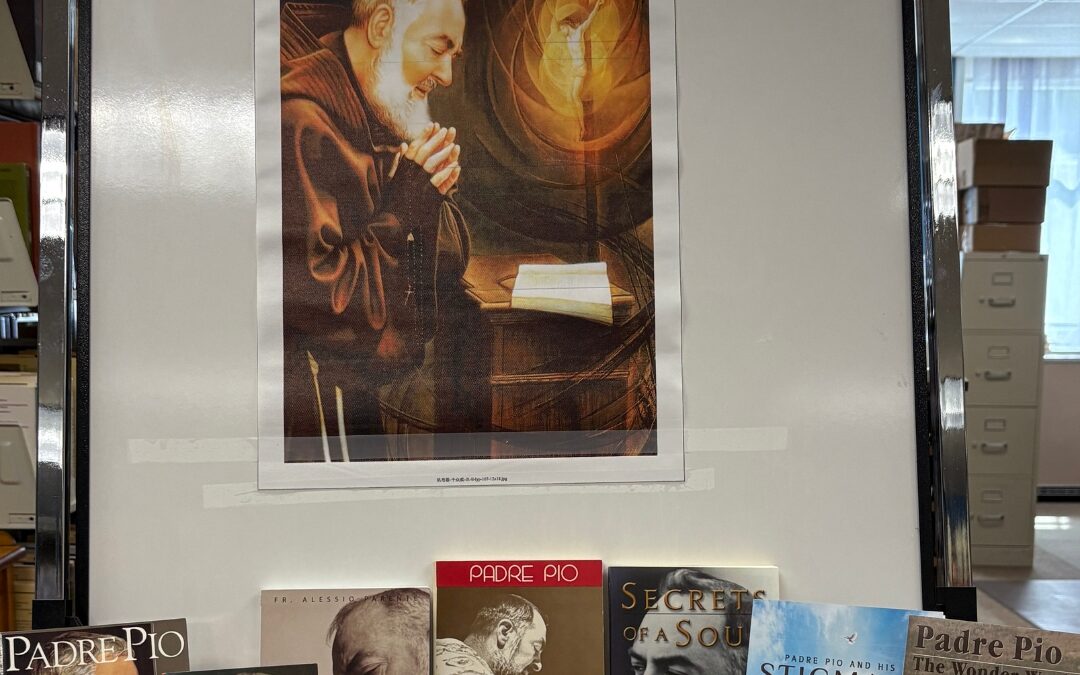
Jul 1, 2025 | Library
SAINT PADRE PIO BACKGROUND
Pio of Pietrelcina (May 25 1887 – September 231968), widely known as Padre Pio. He was an Italian Capuchin friar, priest, stigmatist, and mystic. He is venerated as a saint in the Catholic Church, celebrated on September 23rd.
Pio joined the Capuchins when he was fifteen and spent most of his religious life in the convent of San Giovanni Rotondo. In September 1918, Pio began to display permanent wounds on his hands and feet, known as stigmata in reference to Christ’s wounds. This led to several investigations by the Holy See. In the next months, his reputation of sainthood grew rapidly in the region of San Giovanni Rotondo, attracting hundreds of believers to the monastery, coming each day to see him. Those close to him attest that he began to manifest several spiritual gifts, including the gifts of healing, bilocation, levitation, prophecy, miracles, and extraordinary abstinence from both sleep and nourishment.
He was beatified on May 2, 1999 and canonized on June 16, 2002, by Pope John Paul II. His relics are exposed in the sanctuary of Saint Pio of Pietrelcina, next to the convent of San Giovanni Rotondo, now a major pilgrimage site.
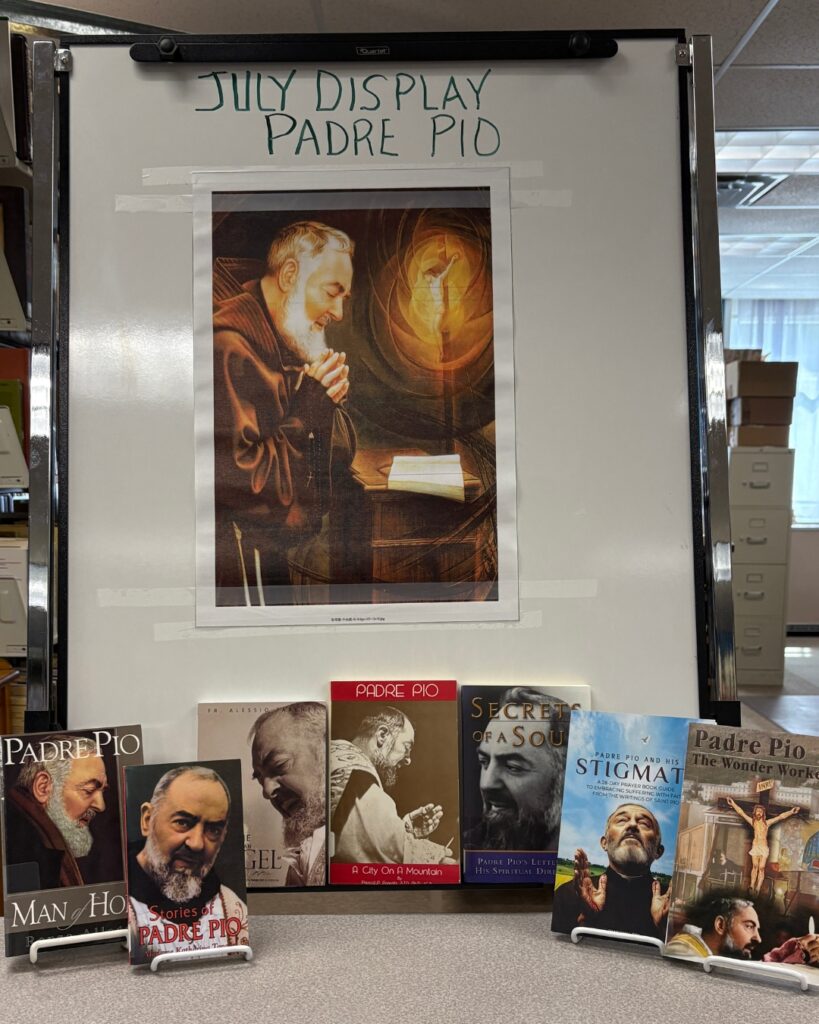
SAINT PADRE PIO – BIBLIOGRAPHY
Allegri, Reno. Padre Pio Man Of Hope. Ann Arbor, MI: Charis Servant Publications. 2000.
Fide, Michael. Padre Pio and His Stigmata. Wheaton, IL: Holy Voices Media. 2024.
Mandato, Graziella DeNuncia. Encounters with a Spiritual Daughter from Pietrelcina. Sea Bright, NJ: Angelus Media Distribution. 2002.
Parente, Fr. Alessio. Send Me Your Guardian Angel. Italy, San Giovanni Rotondo: 2015.
Parente, Pascal P. Padre Pio: A City on a Mountain. Washington, NJ: Ave Maria Institute. 1968.
Pasquale, Gianluigi. Secrets of a Soul: Padre Pio’s Letters to His Spiritual Directors, Boston, MA: Pauline Books. 2003.
Regan, Frank M. Padre Pio and America. Rockford, IL: Tan Books. 2004.
Ruffin, C. Bernard. Padre Pio The Wonder Worker. New Bedford, MA: Franciscan Friars of the Immaculate. 1999.
Tangari, Madame Katharina. Stories of Padre Pio. Rockford, IL: Tan Books. 1996.




 C.S. Lewis on Grief invites readers into the unguarded, luminous honesty of a mind and heart walking through loss. Drawing deeply from A Grief Observed and related writings, this collection showcases Lewis at his most personal: wrestling with God, naming sorrow without varnish, and tracing the bewildering currents of anger, fear, numbness, and aching love that bereavement brings. Here is not a clinician’s distance but a companion’s nearness—an eloquent witness who refuses easy answers and instead offers language for what so often feels unspeakable.
C.S. Lewis on Grief invites readers into the unguarded, luminous honesty of a mind and heart walking through loss. Drawing deeply from A Grief Observed and related writings, this collection showcases Lewis at his most personal: wrestling with God, naming sorrow without varnish, and tracing the bewildering currents of anger, fear, numbness, and aching love that bereavement brings. Here is not a clinician’s distance but a companion’s nearness—an eloquent witness who refuses easy answers and instead offers language for what so often feels unspeakable. Ave Maria: See Learn and Meditate on the Mysteries of the Rosary is a beautiful companion for anyone seeking to enter more deeply into this timeless prayer. With a gentle, accessible approach, it reveals the Rosary as a path of love through the life of Christ and Our Lady—seen, learned, and lived in the heart.
Ave Maria: See Learn and Meditate on the Mysteries of the Rosary is a beautiful companion for anyone seeking to enter more deeply into this timeless prayer. With a gentle, accessible approach, it reveals the Rosary as a path of love through the life of Christ and Our Lady—seen, learned, and lived in the heart. This edition of the 14 epistles of St. Paul presents the complete text from the King James Version of the Bible and illustrates it with a rich variety of illuminated manuscripts and other paintings. 200 full-color illustrations.
This edition of the 14 epistles of St. Paul presents the complete text from the King James Version of the Bible and illustrates it with a rich variety of illuminated manuscripts and other paintings. 200 full-color illustrations. The Loeb Classical Library is a long-running series of books that presents the texts of ancient Greek and Latin authors with authoritative English translations on facing pages. Founded by James Loeb in 1911 and published by Harvard University Press, the series aims to make classical literature accessible to both scholars and general readers.
The Loeb Classical Library is a long-running series of books that presents the texts of ancient Greek and Latin authors with authoritative English translations on facing pages. Founded by James Loeb in 1911 and published by Harvard University Press, the series aims to make classical literature accessible to both scholars and general readers.






